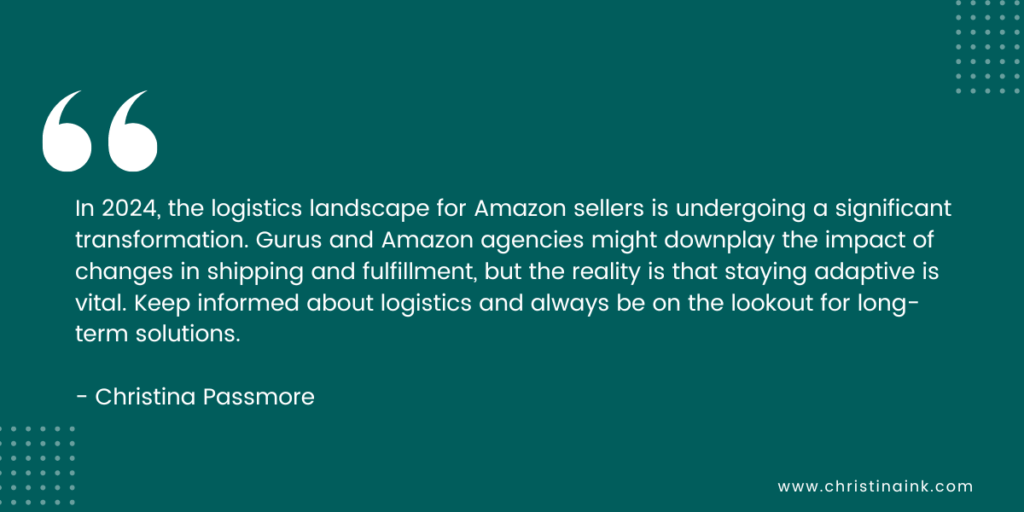Amazon used to be the go-to spot for cashing in on digital dreams. But lately, there’s a buzz online that Amazon isn’t the money-making hub it used to be. Is selling on Amazon worth it in 2024? How do you really make money on Amazon?
Today, we’re unveiling the secrets of how to make money on Amazon with some hard truths and eye-opening realities. Unravel the strategies you need to learn to transform your Amazon side hustle into a thriving online business.
You Need Money to Make Money

The foundation of any successful Amazon business hinges on product research, market research and money. Any Amazon guru telling you otherwise is out to make a buck off your inexperience. Sounds harsh? Just look around at the number of gurus touting quick profits across social media.
From sourcing products and managing inventory to marketing and rising costs, having a robust financial foundation is vital to your success. How much money do you need to sell on Amazon? That all depends on your total landed costs of goods, logistics, marketing, reorder costs and more. A rough estimate is about $10k but you need to crunch some numbers before purchasing inventory.
Can You Realistically Make Money on Amazon?
The answer is yes, you can realistically make money on Amazon. The platform provides an array of opportunities for people willing to put in the effort and time. Whether you’re an aspiring entrepreneur or a side-hustler looking to supplement your income, Amazon offers various ways to tap into its vast customer base. From selling physical products to leveraging Amazon’s affiliate program or even publishing e-books through Kindle Direct Publishing (KDP). Building a sustainable income stream requires dedication, continuous learning, and adaptability to the dynamic nature of e-commerce
How Do Amazon Fees Impact Your Bottom Line?

One thing you need to know about how to make money on Amazon is that Amazon fees affect your profit margins. Amazon fees are influenced by various factors, including the extensive infrastructure required for Amazon’s vast logistics network, investments in technology and innovation, as well as the costs associated with services like fulfillment, storage, and shipping. As the global economy transforms, the prices of products and transportation increase. Amazon fees adapt to meet these needs. Amazon referral fees represent a percentage of the item’s sale price. Fees are conducted per-cubic-foot, and are applied for:
- Storage
- Packing and shipping
- Logistical and operational support
You’ll also pay a monthly subscription fee for your professional selling account which provides access to advanced features and analytics. Shipping and logistics fees, associated with specific shipping requirements, contribute to overall order fulfillment costs. Variable closing fees, applied to certain categories per item sold, help cover costs related to specific product types. Storage fees are determined by the duration of time inventory is housed in Amazon fulfillment centres. If items in Amazon warehouses remain unsold for more than 180 days, long-term storage fees may incur.
Fees fluctuate based on factors like the size of your product, time of the year, and whether your inventory is categorized as standard or oversized. You’ll also have to consider Amazon advertising fees, which help boost your products visibility and position on prime pages.
Amazon fees without a doubt affect your bottom line and need to be well-considered throughout all stages of your selling trajectory. It’s no longer enough to focus solely on top-line revenue; successful sellers pay equal attention to their bottom line, factoring in all costs to ensure a sustainable and profitable business.
What You Need to Know About Logistics and Your Bottom Line
The Amazon logistics landscape is undergoing a significant transformation to suit the needs of Amazon’s enterprise and ever-expanding customer base. With these changes come pros and cons for every seller. Staying adaptive is vital. Keep informed about logistics and always be on the look out for long term solutions.

Build a resilient supply chain, explore alternative shipping solutions, and stay ahead of logistics trends to minimize disruptions and maintain customer satisfaction. The ability to pivot swiftly in response to logistical challenges is a hallmark of a successful Amazon businesses in 2024.
A Multichannel Approach Is the Best Approach in 2024
Relying solely on Amazon for your e-commerce business may have been viable in the past, but in 2024, a multichannel approach is no longer a luxury – it’s a necessity. After building familiarity with the Amazon marketplace, it’s essential to adopt a multi-channel approach so you are not reliant on one channel.
Savvy sellers expand their horizons and diversify across various e-commerce platforms, and even establish their own personal brands. They leverage social media and social selling as major drivers of success. With the ever-evolving A9 algorithm and continuous updates to Amazon policies, a multichannel approach ensures that your business remains robust, adaptable, and capable of weathering changes in the competitive e-commerce landscape. Consider social selling on platforms like TikTok and YouTube, expand to different marketplaces like Walmart, and aim to build your own fully functioning e-commerce website where customers can interact and purchase directly from your business.
How Much Money Can You Make on Amazon?
The amount of money a seller can make is influenced by factors such as their chosen niche, product differentiation, marketing, advertising, competition, and overall business acumen. Some sellers may experience rapid growth and substantial profits, while others may face challenges and more modest returns. Some may even not profit at all and have to find a new product or start another online venture.
The potential for earnings on Amazon in 2024 is substantial, but success demands a combination of strategic decision-making, adaptability, and a clear understanding of the dynamic e-commerce landscape. Sellers who approach the platform with realistic expectations, a willingness to learn, and a commitment to ongoing optimization are better positioned to unlock full earning potential.
Gurus a might peddle a set-it-and-forget-it mentality, but the reality is that continuous adaptation is the lifeline to a thriving Amazon business. Being proactive in monitoring industry trends, being adaptable to tweak marketing strategies, and staying informed about changes in Amazon’s policies are essential components of a successful long-term strategy.
Can I Make $1000 a Month on Amazon?
Maybe yes, maybe no.
There is no set number you will or won’t make selling on Amazon. Is $1000 a month a realistic revenue goal in our opinion? Yes. But that’s revenue, not profit. Distinguish between revenue and profit so you understand when you’re making money on Amazon versus losing money.
What Products Can I Sell on Amazon to Make Money in 2024?
Identifying profitable products and building a profitable Amazon business requires a blend of market research, trend analysis, and a keen understanding of consumer preferences. Leverage AI (ChatGPT) to glean insights about product and market trends, customer behavior and more. Here are some product categories that we feel show promise:
#1 Toys, Hobbies and Games
Toys, hobbies and games encompass a broad spectrum of entertainment, making this category appealing for sellers seeking to tap into a diverse market full of opportunity. Beyond traditional toys, card games have become a popular subcategory, offering interactive and social experiences. Bath games, designed for water-friendly play, provide an innovative twist to traditional toys.
There are numerous unique hobbies where product opportunities abound, catering to niche markets. For example, tabletop role-playing games (RPGs) have gained a dedicated following, presenting opportunities for sellers to provide specialized game accessories, miniatures, and unique rulebooks. Outdoor enthusiasts interested in geocaching may seek specialized equipment, and collectors of rare or vintage toys create a market for unique and limited-edition items.
Understanding the nuances of these niche hobbies and providing tailored products can set sellers apart in the competitive world of toys and hobbies, offering both joy and satisfaction to their diverse customer base.
#2 Health and Wellness Products
This category includes a wide range of items such as vitamins, supplements, fitness equipment, and mindfulness tools. The appeal of health and wellness products lies in the growing focus on self-care and a holistic approach to well-being. Sellers can enhance their offerings by addressing common customer concerns, such as providing transparent information about ingredients, ensuring product efficacy, and offering personalized solutions.
Beyond the mainstream, unique opportunities exist in catering to specific health-conscious niches. For instance, products tailored for individuals following specific diets, like keto or plant-based, can find a dedicated market. Specialized fitness equipment for home workouts, along with innovative mindfulness aids such as meditation apps or stress-relief gadgets, also present avenues for product development.
Understanding the broader wellness landscape and adapting to evolving health trends is crucial for success in this category. As consumers increasingly prioritize their physical and mental well-being, sellers who provide effective, high-quality, and innovative health and wellness products can tap into a market that continues to grow in both size and significance. Be mindful– some categories like supplements pose increased competition where black hat tactics flood the marketplace.
#3 Sustainable and Eco-Friendly Products
The category of sustainable and eco-friendly products is a perfect match for Generation Z, a demographic known for its strong environmental awareness and purchasing power. Gen Z seeks products that align with their values of sustainability and ethical consumption, making eco-friendly alternatives highly appealing. With a keen awareness of environmental issues, this generation appreciates reusable and up-cycled options that minimize waste.
The versatility of sustainable products, ranging from eco-conscious fashion to zero-waste beauty, caters to the diverse interests of this demographic. Businesses targeting Gen Z in this category should emphasize transparency and a genuine commitment to eco-friendly practices, capitalizing on the purchasing power of a generation passionate about making positive contributions to the planet.
#4 Subscription Boxes
Subscription boxes have captured the hearts of consumers, making them an exciting and dynamic product category for sellers. Offering a curated selection of products delivered regularly, these boxes cater to a diverse range of interests, from beauty and grooming to niche hobbies and snacks.
The appeal of subscription boxes lies in the anticipation and joy of receiving a personalized assortment of items. Sellers can enhance their products by staying attuned to customer preferences, responding to feedback, and consistently refreshing the contents to keep subscribers engaged. The flexibility of subscription boxes allows sellers to tap into various niches, ensuring a broad market appeal. Consider niches such as gifts, teacher’s, nurses, flight attendants, self care, speciality and unique food and snacks and more.
The success of this category hinges on providing unique, high-quality items that cater to specific interests, making subscription boxes an enticing prospect for sellers who understand the value of personalized and delightful.
#5 Home Office and Remote Work Essentials
Home office and remote work essentials have become indispensable in the modern work landscape, making this category highly attractive for sellers. With the rise of remote work, there is a sustained demand for ergonomic furniture, productivity tools, and innovative gadgets catering to the needs of the remote workforce.
The appeal lies not only in the functional aspects but also in the adaptability these products offer for creating efficient and comfortable workspaces at home. Sellers can improve existing products by addressing common issues raised by customers, such as designing ergonomic furniture for prolonged comfort or introducing innovative gadgets that enhance productivity. In a dynamic work environment, the success of this category lies in understanding the evolving needs of remote workers and providing solutions that enhance their work-from-home experience.
#6 Personal Care and Beauty Products
Personal care and beauty products hold significant appeal in the e-commerce domain due to their universal relevance, spanning age, gender, and cultural backgrounds. This category, including skincare, haircare, cosmetics, and fragrances, offers sellers a broad and consistent market to tap into. The demand is not just functional; it extends to emotional and psychological benefits, as beauty routines become rituals of self-care and confidence-building. Sellers can enhance their products by addressing common customer concerns, such as formulating skincare with dermatologist-recommended ingredients or creating inclusive makeup lines. The beauty of these products lies in their transformative nature, making them great choices for sellers who understand the evolving landscape of beauty preferences and the desire for holistic well-being.
In a world inundated with choices, a product’s ability to stand out, cater to specific customer desires, and offer a distinctive value proposition is the linchpin for success.
Smart Strategies to Make More Money on Amazon
Running a successful Amazon business involves maximizing revenue and optimizing costs. Here are several savvy strategies to save money and propel your sales goals forward:
#1 Supplier Negotiations
Establishing strong relationships with your suppliers can lead to cost savings. Negotiate terms, bulk discounts, or seek better payment terms. Building a collaborative relationship can make your suppliers more willing to offer favorable terms, ultimately reducing your cost of goods sold (COGS).
#2 Efficient Inventory Management
In 2024 logistics is a big conversation in the Amazon community. To understand why you’ll need to read Amazon’s 2024 fee schedule release and note its promotion of Amazon Global Logistics. Avoid unnecessary storage fees by managing your inventory efficiently. Keep an eye on your stock levels, and plan your restocking cycles to align with demand. By avoiding long-term storage fees and optimizing inventory turnover, you can cut unnecessary costs associated with overstocking.
#3 Small Packaging and Lightweight Products
Optimize your product packaging to reduce both shipping and storage costs. Smaller, lightweight packages often qualify for lower shipping fees, and they also take up less space in Amazon’s fulfillment centres, potentially reducing storage costs. Ensure that your packaging remains protective and visually appealing while being as compact as possible.
#4 Monitor and Adjust Advertising Spend
Hate to say it, but new sellers don’t invest time in learning Amazon pay per click advertising (PPC). They tend to hire expensive PPC agencies that require hefty retainer fees to do the work for them. Outsource once you have a grasp on advertising, or when you can no longer handle the volume yourself. This way you’ll understand advertising nuances when you go to hire the right agency. Regularly review your advertising campaigns to ensure they are cost-effective. Analyze your return on ad spend (ROAS) and adjust your bidding strategy to focus on high-performing keywords. This ensures that your advertising budget is allocated to efforts that generate the most sales.
#5 FBA Reimbursements
Regularly audit your Fulfillment by Amazon (FBA) account for potential reimbursement opportunities. Amazon occasionally makes mistakes, such as losing or damaging your inventory. By diligently monitoring and claiming reimbursements for these discrepancies, you ensure you’re not losing revenue due to errors in Amazon’s processes. You can always employ a reputable reimbursement service but keep in mind they charge different percentage to recoup these fees.
#6 Utilize Amazon’s Free Tools
Leverage the free tools provided by Amazon, such as the Seller Central analytics dashboard. Monitor your sales performance, track customer behavior, and identify areas for improvement. This information can guide your decision-making and help you allocate resources more effectively. Opt for Amazon’s Brand Registry to access additional content assets and stand out from your competitors. These sections of the Amazon product detail page including Amazon product videos are said to impact revenue positively.
#7 Explore Multi-Channel Selling
It’s okay to get your feet wet and start on one platform, but you’ll need to diversify if you want to make more sales and profit. Diversifying sales channels helps mitigate risk and potentially reduce fees. Platforms like eBay, Etsy, Walmart, social selling via TikTok, or your own e-commerce website offer alternative avenues for reaching customers while allowing you to negotiate lower fees and retain more of your revenue.
#8 Minimize Returns
Take steps to reduce product returns by providing accurate product descriptions, high-quality images, and excellent customer service. Avoid selling electronics or products that require strict approvals within your first year. Certain categories like footwear and clothing are notorious for returns and can greatly impact your bottom line as a new seller. Decreasing return rates not only saves on return shipping costs but also preserves your product’s resale value and your integrity as a brand.
#9 Consider DIY Services
Consider handling certain tasks in-house. Explore fulfilling your own orders (FBM – Fulfillment by Merchant) instead of relying solely on FBA. FBM can result in lower fulfillment costs for certain products.
By implementing these strategies, you can create a more cost-effective and streamlined operation on Amazon, helping you save money while working towards and exceeding your sales goals. It’s a delicate balance between maximizing revenue and optimizing expenses, but these measures in combination can contribute to a more financially efficient and sustainable business.
Can You Still Make Money on Amazon?
Simply put– yes, you can still make money on Amazon. Sure, the marketplace has evolved. But with adaptive, smart strategies you can unlock success. Whether you’re differentiating a top-selling product, fine-tuning your product listings, carving a unique brand persona, or negotiating with suppliers, success awaits those who approach the platform with creativity and diligence. Navigating Amazon with a sharp eye and a savvy mindset can lead to success and financial gains in 2024 and beyond.
Questions about how to make money on Amazon? Drop them in the comments. Connect with Christina on LinkedIn for more honest Amazon takes and content marketing tips and tricks.

LIKE THIS ARTICLE?